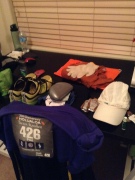Since I just ran a marathon a couple of weeks ago, I was interested in reviewing what the recent trends and statistics are looking like for marathoners primarily focusing on the Masters (40+) and Grand Masters (50+) age groups . The statistics referenced come from Running USA.
In 2012, there were 487,000 marathon finishers in the USA. This is slightly less than in 2011 but only because the New York City Marathon, usually the largest in the world, was cancelled due to a hurricane. If the expected number of finishers were added, the overall number of marathon finishers would have been slightly higher than in 2011. At least from the marathon point of view, there’s not a growing running boom going on but there is not a reduction either. Let’s take a look at how the genders and age groups are trending. In the 40+ age range, the percentage of  women versus men in the marathon is slowly increasing. In 2006, 60% of marathoners were men while 40% were women. In 2012, that number changed slightly to 58% men and 42% women. In 2012, 35% of all men marathoners were over 45 years of age while 23% of all women marathoners were over 45. Overall, from 2006 – 2012, the percentage of marathoners both men and women over the age of 45 has remained steady at 46%. When looking at all marathoners in 2012, the median age for men was 40 and 35 for women. Interestingly, after years of improvement in average marathon finishing times, the times for both men and women have increased year over year from 2010 to 2012. There is not an obvious answer as to why this may be happening. A possible explanation may be that an increasing ratio of casual versus serious runners are entering the marathon ranks but that’s just speculation. I have no data to support that statement.
women versus men in the marathon is slowly increasing. In 2006, 60% of marathoners were men while 40% were women. In 2012, that number changed slightly to 58% men and 42% women. In 2012, 35% of all men marathoners were over 45 years of age while 23% of all women marathoners were over 45. Overall, from 2006 – 2012, the percentage of marathoners both men and women over the age of 45 has remained steady at 46%. When looking at all marathoners in 2012, the median age for men was 40 and 35 for women. Interestingly, after years of improvement in average marathon finishing times, the times for both men and women have increased year over year from 2010 to 2012. There is not an obvious answer as to why this may be happening. A possible explanation may be that an increasing ratio of casual versus serious runners are entering the marathon ranks but that’s just speculation. I have no data to support that statement.
Other interesting statistics about marathoners are that they run an average of 4.3 days and 28.3 miles per week and they purchased an average 3.5 pairs of running shoes during the year. That demographic sounds pretty close to the marathoners I know.
